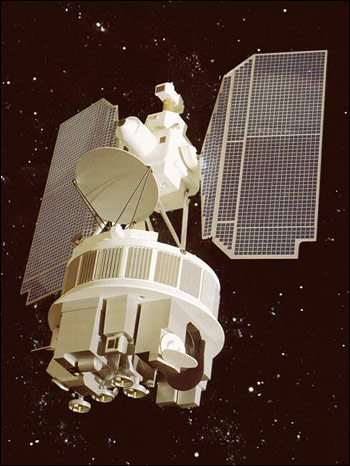

 |
Nimbus: 40th Anniversary |
||
|
On August 28, 2004, NASA celebrated the 40th anniversary of the launch of the Nimbus-1 Earth-observation satellite. Starting in 1964 and for the next twenty years, the Nimbus series of missions was the United States’ primary research and development platform for satellite remote-sensing of the Earth. The seven Nimbus satellites, launched over a fourteen-year period, shared their space-based observations of our planet for thirty years. Each mission taught scientists not only something new about the Earth system, but also taught them something new about how to create, operate, and improve the technology for observing the Earth from space. |
|||

|
The image at left is an artist’s drawing of the general design of the Nimbus series of satellites. The solar-panel “wings” move throughout the day to track the Sun during the daylight part of the satellite’s orbit. The 10-foot-tall satellite has the attitude control system on top, separated from a 5-foot-diameter “sensory ring” (center) with scaffolding. The sensory ring holds the batteries and electronics for each of the sensors that are mounted underneath the ring (bottom). Image taken from Madrid, C.R., ed. (1978) The Nimbus 7 Users’ Guide. Goddard Space Flight Center: National Aeronautics and Space Administration. |
||
|
Over the Nimbus Project’s thirty-year history, the satellites increased the scientific community’s knowledge of the Earth’s atmosphere, land surface and ecosystems, weather, and oceanography. When Nimbus 1 launched in 1964, it gave meteorologists their first global images of clouds and large weather systems. By the time the second Nimbus mission went into orbit in 1966, the sensors onboard were sophisticated enough to measure the temperature of the ocean. Nimbus 3 in 1969 added atmospheric temperature observations and the ability to measure solar radiation above the atmosphere. In 1970, Nimbus 4 began collecting our first global observations of the ozone layer, and by 1972, scientists and engineers had incorporated into Nimbus 5 the capability to measure rainfall over the world’s oceans and to map and monitor sea ice. Taking the atmosphere’s temperature became more sophisticated with Nimbus 6 in 1975, which gave scientists the first satellite-based measurements of atmospheric temperature at different altitudes. The final mission, Nimbus 7, which was launched in 1978, collected data on ozone, the stratosphere, ocean conditions, and global weather until 1994. Experimental users quickly came to depend on Nimbus observations for everything from hurricane forecasting to search and rescue. While providing these important operational data, each Nimbus spacecraft also carried instruments that demonstrated and tested new techniques for measuring different parts of the Earth system. In that capacity, the Nimbus missions became a driving force behind remote-sensing innovation. NASA transferred the technology tested and refined by the Nimbus missions to the National Oceanic and Atmospheric Administration (NOAA) for its operational satellite instruments. The technology and lessons learned from the Nimbus missions are the heritage of most of the Earth-observing satellites NASA and NOAA have launched over the past three decades. Even today, scientists use data from the Nimbus missions to study the Earth system and climate change. The following page includes summaries of presentations that prominent Earth scientists gave at the Nimbus anniversary celebration at NASA’s Goddard Space Flight Center (GSFC) in August 2004. Each scientist spoke about one or more important contributions that NASA’s Nimbus missions made to our understanding of our home planet. For readers who want greater detail, the scientists’ presentations are available via links to the GSFC Laboratory for Atmospheres Website. |

The Nimbus series of satellites made groundbreaking contributions to Earth system science. Throughout three decades of missions, the satellites helped advance our knowledge of (top to bottom) ocean chlorophyll, the changes in Earth’s energy balance from year to year (pictured as the standard deviation in Watts per square meter), global amounts of water vapor and liquid water in the air, global movements of dust and smoke, and the technology—such as this spectrometer—needed to observe the atmosphere from space. |